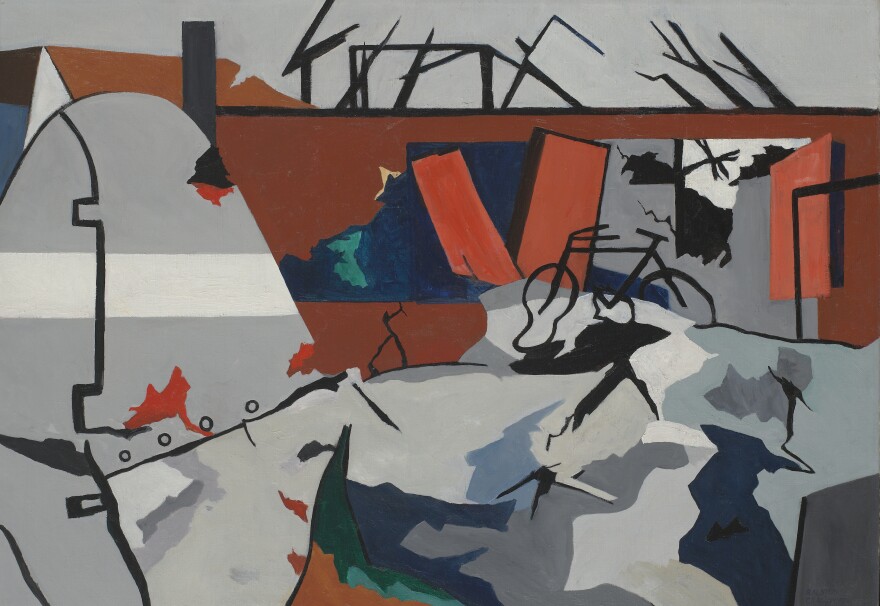Ralston Crawford loved shapes, lines, and color. In the 30’s, he painted industrial buildings, silos, and massive bridges. He depicted what some artists believed was the bright future of America. “Technology and industry was the answer,” says his son John Crawford. Ralston Crawford saw industry as “the emancipation from nature.”
Crawford believed air travel provided that freedom. He took photos over the wings of small planes looking down on miles of fields in Ohio. These images became abstract paintings that suggest the collapsing of space and time. During World War II, Crawford served in the weather division in Washington D.C., creating the graphic designs for weather maps that are still used today.
Emily Schuchardt Navratil is the curator at the Vilcek Foundation who created the exhibit. She says Crawford’s job also required studying images in classified military journals. “Sitting at his desk at Bolling Airfield, and just having these photographs of plane crashes, he was just inundated by this imagery of destruction.”

Crawford transformed elements from one of these photos to create the painting “Bomber,” the aftermath of a plane that crashed into a building. There are no smooth lines or serene colors as in his early works. Jerry Smith, curator at the Dayton Art Institute describes the painting, “You see the hard edge, the jagged forms, it’s not a comfortable painting. So much of it is this grey, mechanical, stone, broken concrete. It’s just a beautifully painted image of a horrific scene.”

Just a year later, Crawford got a commission to paint an aircraft factory in Buffalo, New York. For three days, he made countless photographs and sketches, fascinated by the parts of planes and all the machinery. Navratil suggests this was a complex experience for Crawford. “ And he’s watching the beauty of the construction of these aircrafts, which, you know, had altered his perception when he’s flying, but then to know that, you know, most of the planes they’re making there are Warhawks, and that they’re bombing all of these cities.”
Then in 1946 Crawford is the only artist to witness the atom bomb tests in the Marshall Islands. His son says that ten thousand artists applied for the opportunity to visually tell the story for "Fortune" magazine. John Crawford recalls this moment from his father. “And everyone was given protective eyewear. And he told me that he wanted to see the bomb go off. And so he took off the eye wear. But he covered one eye.”

Crawford’s paintings of the bomb reveal that raw experience of seeing. There is no mushroom cloud in the paintings, says Jerry Smith. He describes the impact of the painting “Test Able,” “This brilliant yellow of the explosion itself, the moment this explosion is happening, with this radiating orange coming off of it are intended to kind of disorient and blind the viewer. If you think of that shape on the left, the blue as water, then you do get this building up effect of an explosion that just keeps coming at you.”
After the war, Crawford returned to his images from the aircraft plant, but his experience of the bomb led to greater abstraction in his work, says Navratil. “And so I think that really tempers that optimism, that celebration of American industry and creation of aircraft plants.”

From Crawford’s photos and sketches, we can recognize the parts from the factory that now appear as floating shapes of different colors. But the shapes seem shuffled on top of each other like a deck of cards, says Jerry Smith. “So maybe he is trying to make an order out of chaos or is he taking what he sees and making it a little more chaotic because that’s the experience he had.”
John believes his father’s art still matters in our time of uncertainty and war.
"He gives us, in a very beautiful way, information about our dark side, our capacity to destroy," states Crawford. "I mean it’s tempting to say we’re on the brink of a much larger destruction. And it certainly recalls…it’s…it’s us."
The paintings that are featured or indirectly referenced in the story are Untitled (Blue and White), Bomber, Test Able, and Factory with Yellow Center shape.
Support for Culture Couch comes from WYSO Leaders Frank Scenna and Heather Bailey, who are proud to support storytelling that sparks curiosity, highlights creativity and builds community.
Culture Couch is created at the Eichelberger Center for Community Voices at WYSO.


